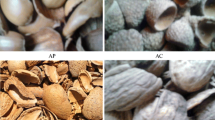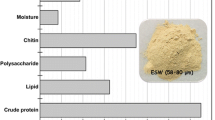Abstract
Pyrolysis of seaweed (Enteromorpha clathrata), rice husk, and five kinds of samples of blended Enteromorpha clathrata and rice husk (at different mass ratios as 3:1, 2:1, 1:1, 1:2, and 1:3) was investigated with thermogravimetric–infrared–mass spectrometry analysis. The results indicated that the pyrolysis of seaweed and rice husk can be divided into four stages: evaporation, depolymerization, devolatilization, and carbonization. However, due to the major pyrolysis component differences between seaweed and rice husk, the pyrolysis characteristics between them varied significantly. Through differential scanning calorimetry analysis, seaweed showed a special exothermic reaction during the stage of precipitation of main volatiles, while the rice husk showed mainly an endothermic reaction in that process. But it appeared to be an exothermic process during pyrolysis of the seaweed and rice husk mixture. We can infer that there was mutual promotion between the seaweed and rice husk, and energy coupling was realized. Meanwhile, it can be concluded that the experimental value of thermal mass loss rate turns out to be higher than that of theoretical value in the process of the main stage of pyrolysis through the comparison between the experimental data and the theoretical data for calculated DTG curves in the pyrolysis of blended sample of different proportions of seaweed and rice husk. The FTIR analysis indicated that with the increasing proportion of the rice husk, the volatile gas, sulfurous gas, and nitrogen gas are decreasingly released from the process of pyrolysis. Judging from the thermogravimetric–mass spectrometry, the pyrolysis of the blended mixture of seaweed and rice husk has been affected because of the increasing amount of rice husk. This reduced the emission of NO, NO2, and SO2 gases which are released from the above process of pyrolysis. Therefore, for the pyrolysis of mixed seaweed and rice husk, there was actually a synergistic effect rather than the simple sum of the characteristics of the pyrolysis of different components.















Similar content being viewed by others
References
Demirbas A. Biodiesel from oilgae, biofixation of carbon dioxide by microalgae: a solution to pollution problems. Appl Energy. 2011;88:3541–7.
Sharma A, Pareek V, Zhang DK. Biomass pyrolysis—a review of modelling, process parameters and catalytic studies. Renew Sustain Energ Rev. 2015;50:1081–96.
Shen DK, Gu S, Luo KH, Bridgwater AV, Fang MX. Kinetic study on thermal decomposition of woods in oxidative environment. Fuel. 2009;88:1024–30.
Aresta M, Dibenedetto A, Barbeiro G. Utilization of macro-algae for enhanced CO2 fixation and biofuels production: development of a computing software for an LCA study. Fuel Process Technol. 2005;86:1679–93.
Phukan MM, Chutia RS, Konwar BK, Kataki R. Microalgae Chlorella as a potential bio-energy feedstock. Appl Energy. 2011;88:3307–12.
Jung KA, Lim SR, Kim Y, Park JM. Potentials of macroalgae as feedstocks for biorefinery. Bioresour Technol. 2013;135:182–90.
Nakorn W, Taro S, Wiwut T. Pyrolysis behaviors of rice straw, rice husk, and corncob by TG–MS technique. J Anal Appl Pyrolysis. 2007;78:265–71.
Yanik J, Stahl R, Troeger N, Sinag A. Pyrolysis of algal biomass. J Anal Appl Pyrolysis. 2013;103:134–41.
Pappa AA, Tzamtzis NE, Statheropoulos MK, Parissakis GK. Thermal analysis of Pinus halepensis pine-needles and their main components in the presence of (NH4)2HPO4 and (NH4)2SO4. Thermochim Acta. 1995;261:165–73.
Maddi B, Viamajala S, Varanasi S. Comparative study of pyrolysis of algal biomass from natural lake blooms with lignocellulosic biomass. Bioresour Technol. 2011;102:11018–26.
Ahamad T, Alshehri SM. TG–FTIR–MS (evolved gas analysis) of bidi tobacco powder during combustion and pyrolysis. J Hazard Mater. 2012;199&200:200–8.
Yang E, Meng JN, Hu HJ, Chen WF. Chemical composition and potential bioactivity of volatile from fast pyrolysis of rice husk. J Anal Appl Pyrolysis. 2015;112:394–400.
Zou SP, Wu YL, Yang MD, Li C, Tong JM. Pyrolysis characteristics and kinetics of the marine microalgae Dunaliella tertiolecta using thermogravimetric analyzer. Bioresour Technol. 2010;101:359–65.
Huang YF, Kuan WH, Chiueh PT, Lo SL. Pyrolysis of biomass by thermal analysis–mass spectrometry. Bioresour Technol. 2011;102:3527–34.
Ross AB, Jones JM, Kubacki ML, Bridgeman T. Classification of macroalgae as fuel and its thermochemical behavior. Bioresour Technol. 2008;99:6494–504.
Wang J, Wang G, Zhang MX, Chen MQ, Li DM, Min MF, Chen MG, Zhang SP, Ren ZW, Yan YJ. A comparative study of thermolysis characteristics and kinetics of seaweeds and fir wood. Process Biochem. 2006;41:1883–6.
Raveendrank K, Ganesh A, Kartic KC. Pyrolysis characteristics of biomass and biomass components. Fuel. 1996;75:987–98.
Park DK, Kim SD, Lee SH, Lee JG. Co-pyrolysis characteristics of sawdust and coal blend in TGA and a fixed bed reactor. Bioresour Technol. 2010;101:6151–6.
Yang HP, Yan R, Chen HP, Lee DH, Zheng CG. Characteristics of hemicellulose, cellulose and lignin pyrolysis. Fuel. 2007;86:1781–8.
Sanchez-Silva L, López-González D, Villaseñor J, Sánchez P, Valverde JL. Thermogravimetric–mass spectrometric analysis of lignocellulosic and marine biomass pyrolysis. Bioresour Technol. 2012;109:163–72.
Boonstra MJ, Tjeerdsma B. Chemical analysis of heat treated softwoods. Eur J Wood Wood Prod. 2006;64:204–11.
Acknowledgements
This work was supported by the National Natural Science Foundation of China (51676091, 51306078), China Postdoctoral Science Foundation funded (2014M560401), and Guangdong province public welfare research and capacity building project (2014A020217008).
Author information
Authors and Affiliations
Corresponding authors
Rights and permissions
About this article
Cite this article
Wang, S., Hu, Y., Wang, Q. et al. TG–FTIR–MS analysis of the pyrolysis of blended seaweed and rice husk. J Therm Anal Calorim 126, 1689–1702 (2016). https://doi.org/10.1007/s10973-016-5762-6
Received:
Accepted:
Published:
Issue Date:
DOI: https://doi.org/10.1007/s10973-016-5762-6




